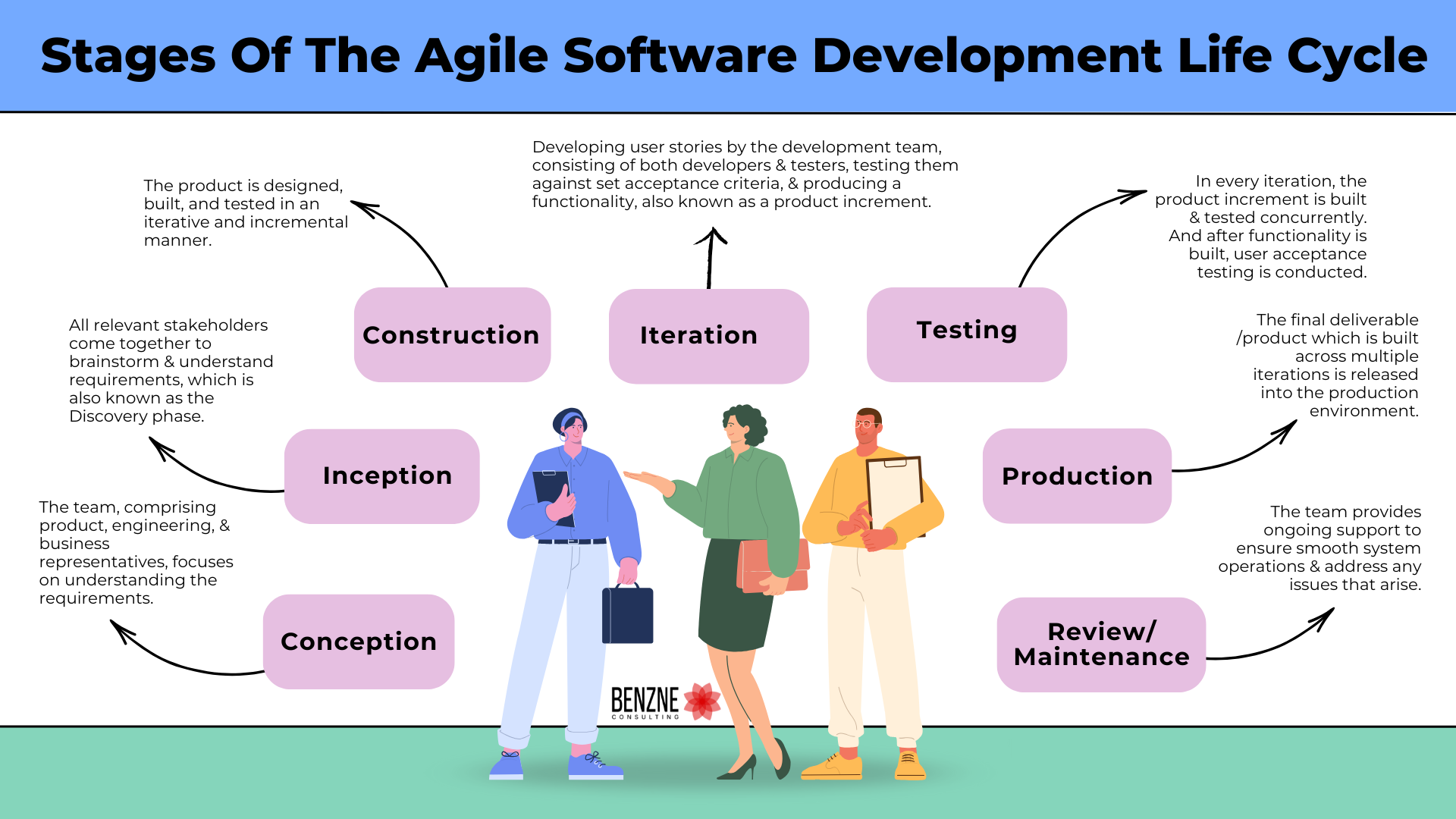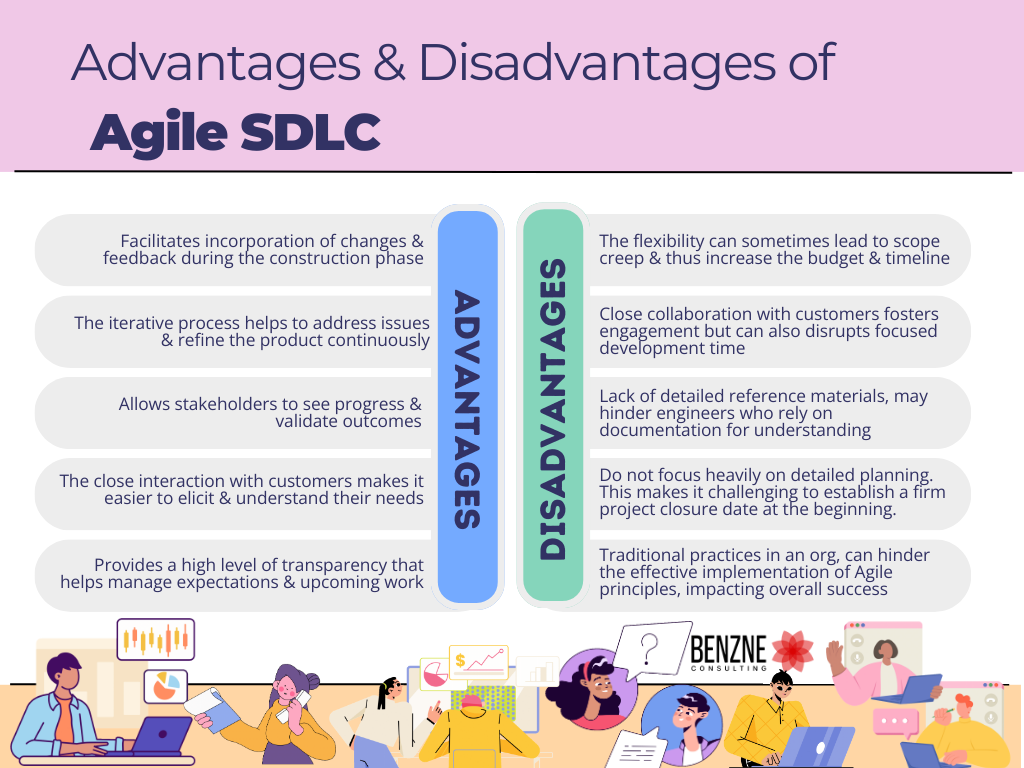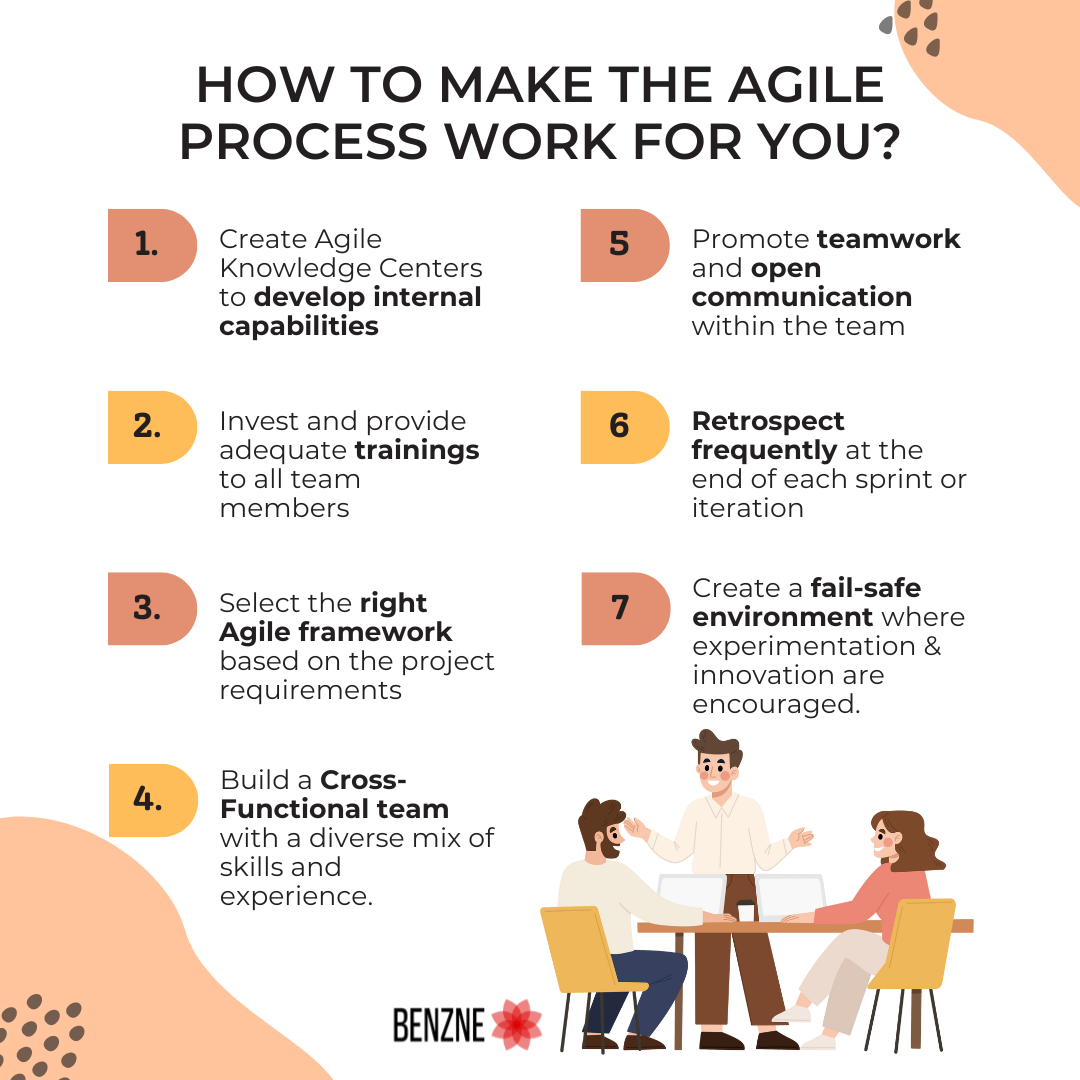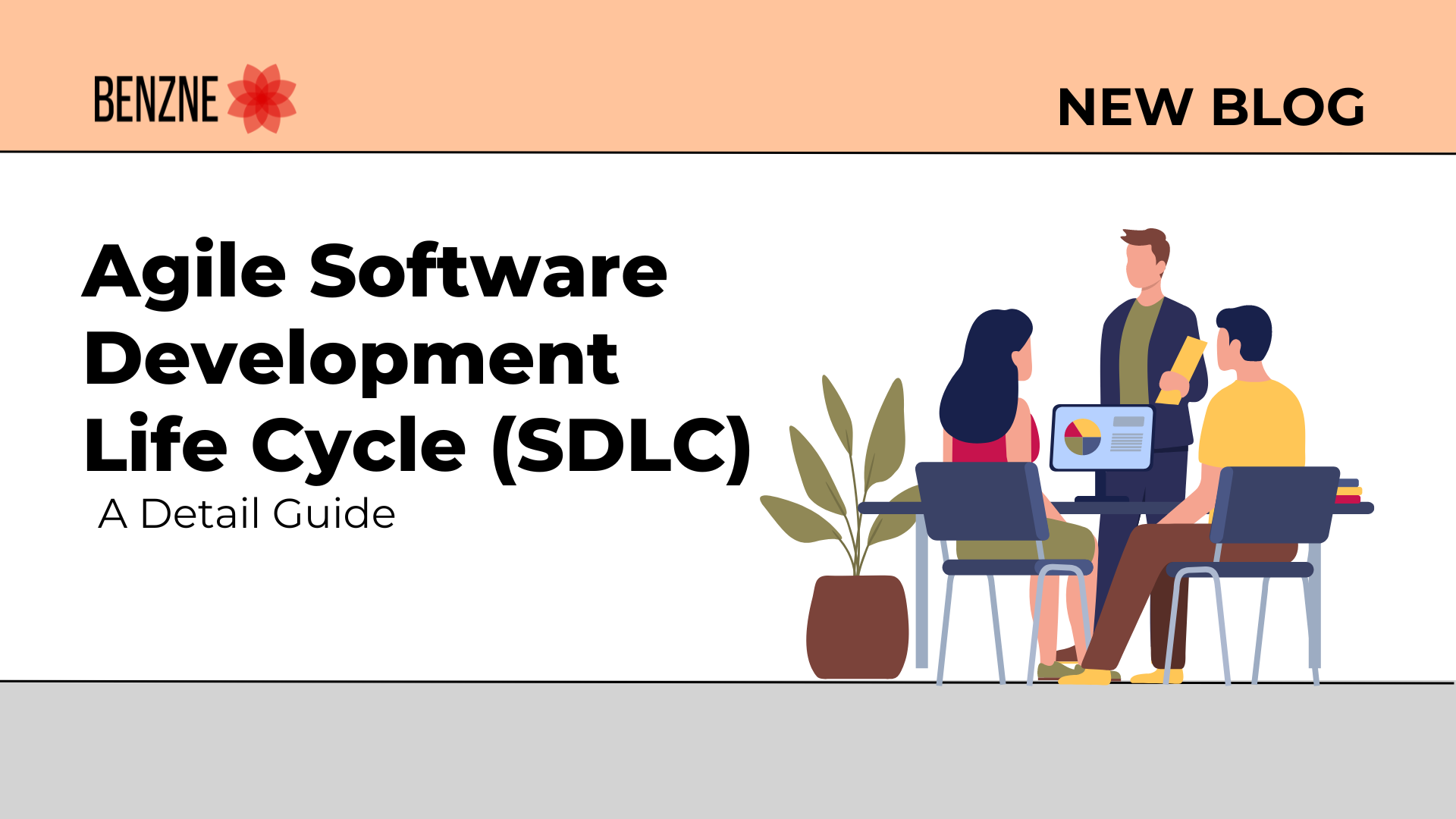Introduction to Agile Software Development Life Cycle
Ever wondered how traditional Software Development Life Cycles (SDLC) differ from agile SDLCs? Or why the concept of Agile SDLC evolved ? Agile software development embraces the dynamic nature of markets and the ever changing needs of customers. And it does this through continuous planning, prototyping and an evolution of deliverables. Unlike the traditional SDLC model which focuses on detailed upfront planning, Agile SDLC focuses on the high-level project outline which will guide the teams into the future, while the detailed elaboration will focus on the present. This blog explores the nitty gritties of Agile SDLC, its various stages and see how Agile SDLC can fit into your projects.
We will cover the following pointers broadly in this blog:
- What is SDLC Software Development Life Cycle?
- What is Agile Software Development Life Cycle?
- Various types of SDLC?
- What are the various software development cycle models?
- What are the various SDLC life cycle phases or software development cycle phases?
- Different Software Development Life Cycle SDLC stages or software development cycle stages?
- What are the advantages and disadvantages of agile development SDLC?
- How to make agile development life cycle work for you?
What is a life cycle in Agile?
The term Agile is understood in various ways. It encompasses frameworks, techniques, methods, and more. From our perspective and experience, Agile represents a set of behaviors, concepts, and principles. Embracing these principles in project management brings simplicity, transparency, predictability, early risk identification, and openness. Agile emphasizes frequent planning, replanning, continuous inspection, adaptation, improvement, daily check-ins, sharing work, team collaboration, tracking work, feedback sharing, close customer collaboration and better change management. It acknowledges that project knowledge is always incomplete and that plans need to be revisited and adjusted throughout the project lifecycle.
The Agile lifecycle consists of the following phases: Inception, Elaboration, Construction, and Closure. This Agile project management life cycle which consists of following phases can be used in any non software industry (eg: construction, manufacturing, electronics, HR) as well. Here’s a brief overview of each phase:
1. Inception:
This phase involves generating the initial idea or proposal for a project. This can come from various sources: an internal initiative, a customer request, an RFP (Request for Proposal), a bid outcome, or an innovative idea. The idea is then conceptualized through discussions with various stakeholders, such as customer-facing representatives and engineering teams, to assess the business feasibility and viability of the project. High-level project timelines are established, leading to formal approval to proceed to the next phase.
2. Elaboration:
Once the idea is approved, detailed planning begins. This phase focuses on laying a solid foundation for the project’s success. It involves elaborating on project viability, desirability, and feasibility , to detail what needs to be delivered. Requirement elicitation and a high-level project plan are developed, often through workshops that facilitate collaborative creation and understanding of requirements and deliverables. The level of uncertainty, communication formality, tracking frequency, control measures, and tools for progress tracking are formalized in this phase. A detailed plan for the initial deliverables is created, focusing on the foreseeable future. The planned products are detailed and captured in the form of backlogs.
3. Construction:
Agile emphasizes frequent, incremental, and iterative delivery. In this phase, scheduling and detailed planning and estimation, development of deliverables are carried out collaboratively. The focus is on delivery, where the delivery team selects work based on customer SME (Subject Matter Expert) decisions. Each delivery concludes with a review to gather regular feedback and validate acceptance criteria. Within Agile environments, daily standup meetings are held where delivery teams report progress to each other. These meetings offer a chance to identify and address issues, risks or blockers proactively, ensuring that release goals are met. The construction phase continues until all deliverables of a release or project meet their quality requirements.
4. Closure:
This phase marks the point at which the project’s deliverables are confirmed and the objectives have been met. The product is handed over to the customer, and the operations team takes ownership. Documentation and support activities are carried out, and a formal announcement is made to all stakeholders that the project has been completed. In mature Agile environments, regular handovers of products occur throughout the project due to the iterative and incremental nature of Agile.
What is Agile Software Development Life Cycle?
The Agile Software Development Life Cycle (SDLC) is a step-by-step process that focuses on designing, developing, testing, and frequently releasing software. It is grounded in iterative and incremental development principles. Rather than measuring success by the completion of activities, Agile SDLC emphasizes delivering features as the primary measure of success.
In Agile, teams are adaptable and responsive to changes rather than strictly adhering to a predefined plan. The ultimate goal is to deliver value to the project’s customers. Unlike traditional models that follow a linear and sequential approach through design, development, testing and release, Agile SDLC operates differently.
Depending on the chosen Agile framework, the process typically starts with a brief planning and design phase early in the project. This is followed by continuous analysis, design, development, testing, and release, all happening concurrently within each iteration. Each iteration is a timeboxed duration, usually lasting two to four weeks. During each iteration, functionality is built incrementally. Releases may occur after several iterations, providing regular updates and improvements to the software.
This iterative approach allows teams to adapt to changes, incorporate feedback and continuously enhance the product throughout its development cycle.
Stages Of The Agile Software Development Life Cycle
The Agile iterative approach encompasses several SDLC stages or software development cycle stages throughout its project life cycle:

- Conception – In this phase, the team, comprising product, engineering, and business representatives, focuses on understanding the requirements ( the final deliverable) that triggered the project. They justify the business case, align with the product vision, and assess technical feasibility. The identified problem is further explored, and preliminary high-level estimates of the project’s timelines are created.
- Product Backlog: A list of user stories and requirements, along with work items needed to build the product.
- Architecture and Framework : Establishing the architecture and framework for implementation.
- Proof of Concept (POC): Developing and demonstrating a feasibility prototype, if necessary.
- Release Plan: Creating a release plan that outlines what needs to be developed first, next, and later based on priority, risk, and value.
- Development Team: Identifying the team responsible for implementation.
- Agile Framework: Selecting the Agile framework for the project.
- High-Level Estimates: Establishing and refining initial estimates from the conception phase arriving at a target closure date.Inception- During the Inception Phase, the product requirements are refined further by product and engineering representatives. This phase the requirements are elaborated by engineering, UX, and Quality Assurance (QA) representatives. This collaboration leverages their knowledge and creativity, enables early identification of technical risks and feasibility issues, and helps the team empathize with users. It also aids in making informed design and technical decisions. This collaborative process, where all relevant stakeholders come together to brainstorm and understand requirements, is also known as the Discovery phase.Typical outcomes of the Inception phase include:
- Product Backlog: A list of user stories and requirements, along with work items needed to build the product.
- Construction – The Construction phase focuses on implementation. The product is designed, built, and tested in an iterative and incremental manner. This phase is divided into multiple iterations, each with a fixed duration. The outcome of the construction stage is a releasable product.
- Iteration – An Iteration consists of developing user stories and requirements by a development team consisting of both developers and testers, testing them against set acceptance criteria, and producing a functionality, also known as a product increment. During testing, any defects identified are fixed within the same iteration to qualify the functionality. Each iteration builds on the functionality of the previous one. The iteration begins with a planning activity with the Product Owner prioritizing user stories. The development team then selects the stories or work items for that iteration’s development and testing.
- Testing – Testing is integral to every iteration. In every iteration the product increment is built and tested concurrently. After functionality is built, user acceptance testing is conducted. Upon completion of all requirements, additional testing activities like regression and sanity checks are performed. Non-functional tests are also conducted to assess security, performance, software stability, and data privacy.
- Production – In this phase, the final deliverable /product which is built across multiples iterations is released into the production environment.
- Review/Maintenance – Following the successful release of the product or functionality into operations, the development team transitions to the maintenance phase. During this phase, the team provides ongoing support to ensure smooth system operations and address any issues that arise.
Advantages & Disadvantages of Agile SDLC
The Agile SDLC Software Development Life Cycle is grounded in four core values and twelve principles. Its primary focus is on delivering working software frequently while engaging closely with the customer. Agile development SDLC is particularly useful in rapidly changing environments where requirements are continually evolving. Although Agile offers numerous advantages, it also has its disadvantages. These challenges can often be addressed through the selection of the right framework, effective planning, clear communication, and tailoring the approach to meet specific needs, while incorporating lessons learned from previous implementations.

Advantages:
- Agile facilitates the incorporation of changes and feedback during the construction phase, which can save significant time, effort, and cost. This iterative approach allows for adjustments based on customer input, leading to more refined and relevant solutions.
- The construction phase is divided into short iterations, enabling feedback and course corrections at shorter intervals. This iterative process helps to address issues and refine the product continuously, rather than waiting until the end of development.
- Agile aims to deliver a potentially shippable product at the end of each iteration. This approach builds customer confidence by providing functional, usable increments of the product regularly, allowing stakeholders to see progress and validate outcomes.
- Agile SDLC stages emphasize close collaboration with customers throughout the life cycle. This ongoing interaction makes it easier to elicit and understand customer needs, leading to a product that is more closely aligned with their expectations and requirements.
- The iterative nature of Agile provides a high level of predictability regarding which features will be delivered in future iterations. This transparency helps manage expectations and plan for upcoming work.
Disadvantages:
Agile SDLC Software Development Life Cycle promotes adaptability and responsiveness to change during the development process. However, this approach has its own disadvantages
- Agile encourages continuous incorporation of changes throughout the project. This flexibility can sometimes lead to scope creep, where the project scope expands beyond the initial plans. As a result, this may increase the budget and extend the timeline, making it difficult to manage change costs effectively.
- Agile emphasizes regular collaboration with customers and frequent face-to-face meetings. While this fosters engagement, it can also disrupt focused development time. Teams might find their development efforts interrupted by ongoing communication and coordination activities.
- One of Agile’s core values is prioritizing working software over comprehensive documentation. This can lead to a lack of detailed reference materials, which may hinder engineers who rely on documentation for understanding and continuity, particularly if they are not as comfortable with direct communication.
- Agile does not focus heavily on detailed upfront planning. This can make it challenging to establish a firm project closure date at the beginning. Instead, the end date may only become clearer after several iterations based on the velocity ( number of work items completed) of the team, which can complicate long-term scheduling and resource allocation.
- Agile relies on continuous involvement from clients and customers. If clients are unavailable for feedback or reviews during iterations, it can severely delay the project.
- Organizations adopting Agile SDLC may face difficulties if they are not flexible enough to embrace Agile methodologies fully. Rigid structures and traditional practices can hinder the effective implementation of Agile principles, impacting overall success
Estimate Right in Agile! Use proven agile development estimation techniques to forecast & deliver effectively.
How To Make The Agile Process Work For You?
To make the Agile process work effectively for you, consider the below key practices that align with Agile principles and values. We have captured these pointers from a practitioners point of view, designing and leading multiple agile transformation journeys as an agile consulting and coaching company.

- Create Agile Knowledge Centers to develop internal capabilities, such as Agile champions, evangelists to spread Agile knowledge and best practices across the organization.
- Invest and provide adequate trainings to all team members and stakeholders on Agile principles, methodologies and frameworks
- Select the right Agile framework based on the project requirements, customer engagement levels, risks,and the type of work (e.g R&D, product development).
- Whether it’s Scrum, Kanban, XP, or another approach, align the framework with
to align with project needs - Build a Cross-Functional team with a diverse mix of skills and experience. This ensures all necessary expertise is available within the team to address different aspects of the Agile SDLC process
- Promote teamwork and open communication within the team to leverage collective skills and knowledge.
- Continuously gather feedback from customers to ensure that the product aligns with their needs and expectations. Regular feedback loops help adapt the product to changing requirements and improve customer satisfaction.
- Retrospect frequently at the end of each sprint or iteration to review what went well, what didn’t, and how processes can be improved. This practice fosters a culture of continuous improvement.
- Apply the lessons learned from retrospectives to enhance team practices and processes.
- Select effective Agile project management tools (such as Jira, Trello, or Asana) to visualize tasks, track progress etc. Choose tools that fit your team’s workflow and project drivers
- Ensure that the tools integrate well with other systems and support effective collaboration.
- Provide stakeholders with regular updates on project progress, goals achieved, and any changes in scope or priorities. Transparency is the key. Keep communications open and frequent to manage expectations of stakeholders
- Encourage team members to continuously develop their skills and stay updated with Agile practices.
- Create a fail safe environment where experimentation and innovation are encouraged.
Conclusion
Agile represents a dynamic approach to project management, characterized by its principles of adaptability, transparency, and iterative progress. The Agile development SDLC —comprising Inception, Elaboration, Construction, and Closure—promotes ongoing refinement, frequent collaboration, and incremental delivery. This methodology accommodates changing requirements and fosters continuous improvement. By applying Agile principles, teams achieve early risk detection, maintain effective communication, and ensure high-quality outcomes. Ultimately, Agile facilitates a responsive and efficient development process, leading to successful project completion and enhanced stakeholder satisfaction.
At Benzne Consulting, as an agile transformation company, our key focus is on curating business context driven agile transformation journeys for our clients which are aligned with their core business goals. We will be glad to discuss and explore how we can add tremendous value to your business and your agile transformation.
This brings our blog on “Agile Software Development Life Cycle (SDLC): A Detail Guide” to an end. We sincerely hope this was helpful. In case you need to talk to us or want us to share any feedback, please reach out to us at “consult@benzne.com”
Frequently Asked Questions About Agile Software Development Life Cycle (SDLC)
1. What is the Agile story lifecycle?
A user story, which represents a small requirement broken down from a larger requirement known as an epic, is initially created in a Discovery activity during the Inception phase. During this time, product representatives craft the requirements into user stories. At this stage, only high-level information and initial acceptance criteria are added to the story.
Once the iteration in which the story will be developed is identified, the story undergoes further refinement. This refinement involves detailed discussions between developers, testers, and the Product Owner, adding more specific information and clarifying requirements. This process occurs during the Construction phase.
In the Construction phase, the user story is implemented within the iteration and is tested against the acceptance criteria. If it meets the criteria, the story is then released into the Production stage, making the new feature available to end users.
Measure your team’s agility using the Agile Maturity Matrix. Identify areas for growth and build a stronger, more efficient team with ease.
2. What are the 5 SDLC Software Development Life Cycle models?
Below are the five software development cycle models in no particular order:
- Agile Development SDLC – This model is characterized by iterative and incremental development. Agile emphasizes flexibility and continuous delivery of software in small,frequent increments. Every iteration’s functionality is built on top of the previous iteration’s functionality
- Waterfall Model – This software development cycle model follows a linear and sequential approach where phases such as designing, planning, development, testing, and closure occur one after the other. Each phase must be completed before the next one begins, making it a structured but inflexible approach
- V-Shaped Model – Also known as the Verification and Validation model, the V-Shaped model is not iterative or incremental. It emphasizes a sequential approach where the design phase receives more focus than the implementation phase. Each stage of development is directly linked to a corresponding testing phase, creating a V-shaped progression through the development lifecycle
- Spiral Model– One of the Software development cycle models that combines elements of both iterative and waterfall approaches. It is particularly useful in projects with high risks and requires continuous risk assessment. The Spiral model involves repeating cycles (spirals) of planning, risk analysis, engineering, and evaluation, allowing for frequent reassessment and adjustment
- Iterative Model – This model focuses on breaking down the software development process into smaller, manageable iterations. The product is developed through repeated cycles of designing, developing, and testing, with each iteration bringing the software closer to a fully functional state ready for deployment
These are the most common types of SDLC models.
3. What is the difference between SDLC and STLC?
Software development utilizes the SDLC Software Development Life Cycle model, which comprises SDLC Life Cycle phases such as requirements analysis, planning, development, testing, and closure. One of the critical Software Development cycle phases is testing, which ensures that the developed software meets quality requirements.
The testing phase within the SDLC Life Cycle phases can also be governed by the STLC Software Testing Life Cycle model. While the SDLC can be seen as a superset that includes all stages of software development, the STLC is a subset focused specifically on testing. STLC not only emphasizes quality but also addresses the project’s performance, reliability, and functionality.
4. Which SDLC model is better?
Every SDLC Software Development Life Cycle model comes with its own set of advantages and disadvantages. No single model fits all scenarios perfectly. Factors such as project objectives, clear requirements, fixed scope, and time constraints can influence the choice of an SDLC model. Additionally, the nature of the project whether it is uncertain, has evolving requirements, or requires frequent feedback from customers also plays a crucial role in determining the most suitable SDLC approach.
Collaborate with one of the leading agile consulting firms to enhance your business agility. We provide insights and strategies that help you thrive in competitive and fast-paced markets.


Excellent post! The Agile Software Development Life Cycle offers flexibility and adaptability, which are key for fast-paced projects. A great guide for teams aiming to deliver iterative improvements quickly!